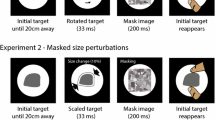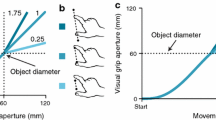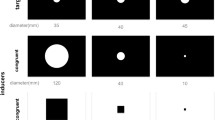Summary
Prehension involves processing information in two hypothesized visuomotor channels: one for extrinsic object properties (e.g., the spatial location of objects) and one for intrinsic objects properties (e.g., shape and size). The present study asked how the two motor components that correspond to these channels (transport and grasp, respectively) are related. One way to address this question is to create a situation where unexpected changes occur at the input level of one of the visuomotor channels, and to observe how the movement reorganizes. If transport and grasp are independent components, then changing the object location, for example, should affect only the transport, not the grasp component. Subjects were requested to reach, grasp and lift as accurately as possible one of three dowels using the distal pads of the thumb and index finger. On certain trials, upon movement initiation towards the middle dowel, the dowel was made to instantaneously change its location to one of the two other positions, requiring the subject to reorient the hand to the new dowel location. Results consisted of comparing the movement characteristics of the transport and grasp components of these perturbed movements with appropriate control movements. Kinematics of the wrist trajectory showed fast adjustments, within 100 ms, to the change of dowel position. This duration seems to correspond to the minimum delay required within the visuomotor system for visual and/or proprioceptive reafferents to influence the ongoing movement. In addition, these delays are much shorter than has been found for conditions where object location changes before movement initiation (approximately 300 ms). The faster times may relate to the dynamic character of the deviant limb position signals, with the only constraint being the physiological delays for visual and kinaesthetic signals to influence the movement. A spatiotemporal variability analysis of the movement trajectories for non-perturbed trials showed variability to be greatest during the acceleration part of the movement, interpreted as due to control by a relatively inaccurate directional coding mechanism. Control during the deceleration phase, marked by low trajectory variability, was seen to be due to a sensorimotor process, using motor output signals, and resulting in an optimized trajectory supporting a successful grasp. Analysis of the grasp component of prehension showed that perturbing object location influenced the movement of the fingers suggesting a kinematic coupling of the two components. However, forthcoming work shows that, when object size changes, and location remains constant, there is a clear temporal dissociation of the two components of prehension. Collectively, these results suggest that the two visuomotor channels have different time constraints with the time-constant of the channel activated by the perturbation constraining the timing of the other.
Similar content being viewed by others
References
Arbib MA (1981) Perceptual structures and distributed motor control. In: Brooks VB (ed) Handbook of physiology, Vol II, Part 2. Motor control. Williams and Wilkins, pp 1449–1480
Bernstein NA (1967) The coordination and regulation of movements. Pergamon, Oxford
Elliott D, Allard F (1985) The utilisation of visual feedback information during rapid pointing movements. Q J Exp Psychol 37A:407–425
Evarts EV, Vaughn WJ (1978) Intended arm movements in response to externally produced arm displacement in man. In: Desmedt JE (ed) Cerebral motor control in man: long loop mechanisms. Progress in clinical neurophysiology. Karger, Basel, pp 178–192
Favilla M, Hening W, Ghez C (1989) Trajectory control in targeted force impulses. VI. Independent specification of response amplitude and direction. Exp Brain Res 75:280–294
Georgopoulos AP, Kalaska JF, Massey JT (1981) Spatial trajectories and reaction times of aimed movements: effects of practice, uncertainty and changes in target location. J Neurophysiol 46:725–743
Georgopoulos AP, Schwartz AB, Kettner RE (1986) Neuronal population coding of movement direction. Science 233:1416–1419
Goodale MA, Pélisson D, Prablanc C (1986) Large adjustments in visually-guided reaching do not depend on vision of the hand or perception of the target displacement. Nature 320:748–750
Jeannerod M (1981) Intersegmental coordination during reaching at natural visual objects. In: Long J, Baddeley A (eds) Attention and performance, IX. Erlbaum, Hillsdale, pp 153–168
Jeannerod M (1986) The formation of finger grip during prehension: a cortically mediated visuomotor pattern. Behav Brain Res 19:99–116
Jeannerod M (1991) The interaction of visual and proprioceptive cues in controlling reaching movements. In: Humphrey DR, Freund HJ (eds.) Motor control: concepts and issues. Wiley, New York (in press)
Johansson RS, Westling G (1987) Signals in tactile afferents from the fingers eliciting adaptative motor responses during precision grip. Exp Brain Res 66:141–154
Lawrence DG, Kuypers HGJM (1968) The functional organization of the motor system in the monkey. I. The effects of bilateral pyramidal lesions. Brain 91:1–14
Lee RG, Tatton WG (1975) Motor responses to sudden limb displacements in primates with specific CNS lesions and in human patients with motor system disorders. Canad J Neurol Sci 2:285–293
Marteniuk RG, Jeannerod M, Athenes S, Dugas C (1987) Constraints on human arm movement trajectories. Canad J Psychol 41:365–378
Paillard J (1982) The contribution of peripheral and central vision to visually guided reaching. In: Ingle DJ, Goodale MA, Mansfield RJW (eds) Analysis of visual behavior. MIT Press, Cambridge, pp 367–385
Paulignan Y, MacKenzie C, Marteniuk R, Jeannerod M (1990) The coupling of arm and finger movements during prehension. Exp Brain Res 79:431–436
Pelisson D, Prablanc C, Goodale MA, Jeannerod M (1986) Visual control of reaching movements without vision of the limb. II. Evidence of fast unconscious processes correcting trajectory of the hand to final position of a double step stimulus. Exp Brain Res 62:303–311
Rizzolatti G, Camarda R, Fogassi L, Gentilucci M, Luppino G, Matelli M (1988) Functional organization of inferior area 6 in the macaque monkey. II. Area F5 and the control of distal movements. Exp Brain Res 71:491–507
Schmidt RA, Zelaznik H, Hawkins B, Franck JS, Quinn JT (1979) Motor output variability: a theory for rapid motor acts. Psychol Rev 86:415–451
Soechting JF, Lacquaniti F (1983) Modification of trajectory of a pointing movement in response to change in target location. J Neurophysiol 49:548–564
Sonderen JF van, Denier van der Gon JJ, Gielen CCAM (1988) Conditions determining early modifications of motor programs in response to changes in target location. Exp Brain Res 71:320–328
Wallace SA, Weeks DL (1988) Temporal constraints in the control of prehensive movements. J Mot Behav 20:81–105
Zelaznik HN, Hawkins B, Kisselburg K (1983) Rapid visual feedback processing in single-aiming movements. J Mot Behav 15:217–236
Author information
Authors and Affiliations
Additional information
Supported by INSERM, Paris
Rights and permissions
About this article
Cite this article
Paulignan, Y., MacKenzie, C., Marteniuk, R. et al. Selective perturbation of visual input during prehension movements. Exp Brain Res 83, 502–512 (1991). https://doi.org/10.1007/BF00229827
Received:
Accepted:
Issue Date:
DOI: https://doi.org/10.1007/BF00229827




